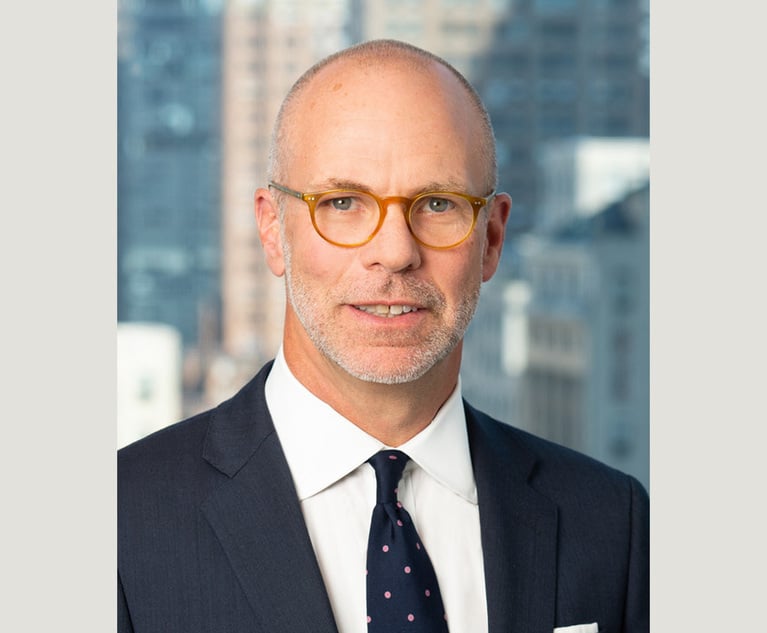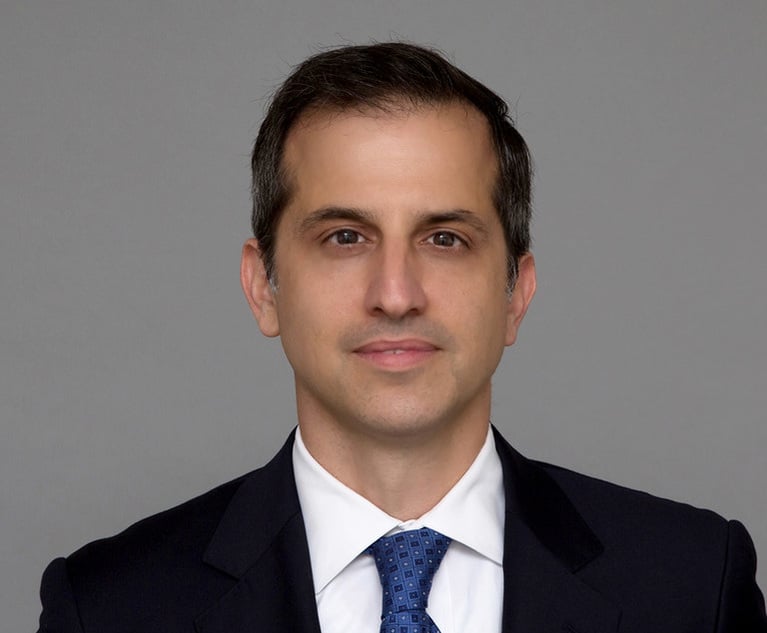 Joseph F. Rice founding member of Motley Rice.
Joseph F. Rice founding member of Motley Rice.Litigation Leaders Across the 'v': Motley Rice's Joe Rice on Childhood Dreams, Calculated Risks and Historic MDLs
'If we accept a case it is with the mindset that it is going in front of a jury, so we do the work to get it there. Sometimes in mass torts, you'll see some lawyers sit back and watch others do the work—Motley Rice lawyers don't do that. We are active in every litigation we are involved in.'
March 01, 2020 at 10:25 PM
11 minute read
Welcome to an occasional spin-off of our "Litigation Leaders" series, "Across the 'v,'" featuring the leaders of top plaintiffs-side firms.
Meet Motley Rice co-founder Joe Rice—though there's a good chance you know his name already. In 1998, Rice and his law partner, the late Ron Motley, along with Dickie Scruggs, brokered the $246 billion tobacco master settlement agreement—the largest civil settlement in U.S. history.
As one of the nation's largest plaintiffs' litigation firms, Motley Rice is currently front and center in the opioid MDL, as well as other complex cases.
Rice shared his thoughts on his career and his firm with Lit Daily.
Lit Daily: Tell us a little about yourself—beyond what's in your law firm bio.
Joe Rice: I was born in Columbia, South Carolina in 1954, when textiles were the base of the economy in the Carolinas. My family moved around a lot as I was growing up so my dad could advance in the industry. My granddaddy was a paymaster in a textile mill in Anderson, South Carolina back in the 1940s and early 1950s, but for some reason, deep in his heart, he always wanted to be a lawyer. He spent his extra money, which there was little of, on law books. They had a hard life.
Hearing my dad tell stories about how he grew up, his father's dedication to his family, about the fear of not being able to take care of his family, and about how that fear may have shaped his own life caused me to set my sights on being the lawyer that my granddaddy could not. These experiences shaped my life goals.
At the end of my four years at the University of South Carolina, in spite of mediocre grades and LSAT scores, I got lucky. The University of South Carolina Law School had a second admission program through a summer pre-admission trial. You went to summer school for law school and took an exam and they admitted a certain number of students from the summer program. That's how I got into law school. I finished with law review, top 10 in the class and clerked for the dean of the law school. I give a great thanks to whomever created that USC Law School summer program.
After law school, my plan was to go to North Myrtle Beach and practice law. I thought if I did really good work and worked the jails on Friday and Saturday nights, and picked up a little real estate practice on the side, I could be successful. That was my plan when I graduated from law school.
Then a man named Ron Motley entered my life in 1979. I was two weeks away from taking the bar exam. Ron calls and says "I want to meet you for a drink." I'd never met Ron and I said "Mr. Motley, I'm studying for the bar." He said, "You need a break." So, I met Ron and he offered me a job in Barnwell, South Carolina working for Blatt & Fales.
He wanted me to work on a case about reprocessing spent nuclear fuel. I had no idea what that was. I talked it over with my wife Lisa and we decided that we'd accept the offer for a two-year commitment and it would be good to be closer to her family in Newberry, South Carolina. Then I was going back to the beach because I love the beach.
That two-year commitment has turned into almost 40 years with that firm. I'm honored that my daughter Ann E. Rice Ervin chose to practice alongside me now.
What's the history of your firm? When/ why/ how did it come into existence?
I began working with Ron Motley (1944-2013) in 1979 at Blatt & Fales. When Mr. Blatt passed away, the firm became Ness Motley. In 2003, after the tobacco case, Ron and I formed Motley Rice LLC to continue the legacy of taking on historic and precedent-setting cases such as asbestos litigation, the historic tobacco master settlement agreement, pioneering anti-terrorism litigation for victims' families and survivors of the 9/11/01 attacks, and many other complex causes.
How big is the firm and where are most of your litigators concentrated geographically?
Motley Rice has 11 offices around the country, with most of our lawyers based out of headquarters in Mt. Pleasant, South Carolina. We currently have more than 150 lawyers and more than 240 support staff. Our practice is a national practice, so many of our lawyers are on the road a lot.
What areas of litigation do you specialize in? Has this evolved over the years?
Both my personal practice and the firm's have evolved over the years. I tried asbestos personal injury cases for many years. When the mass tort and consolidation of actions grew, the focus of the practice grew with it.
Motley Rice has practice areas including securities and consumer fraud, anti-terrorism, human rights, environmental, medical drugs and devices, as well as catastrophic injury, wrongful death cases and our growing public client practice.
Starting out practicing asbestos litigation, then tobacco litigation, I've greatly broadened my practice areas, as have many of our leading attorneys who have worked alongside me, to serve our clients as the firm has grown and expanded. Over the last 20 years, I have focused much of my time on resolution of complex cases including MDLs, tobacco, the BP oil spill, Volkswagen, TVM, and now the opioid litigation.
What do you see as hallmarks of your firm's litigators? What makes you different?
*We don't shy away from difficult cases. We believe in justice, the law and our clients.
*Our cases are challenging and complex, but we accept them anyway, do the hard work, put in the long hours and roll up our sleeves.
*If we accept a case it is with the mindset that it is going in front of a jury, so we do the work to get it there. Sometimes in mass torts, you'll see some lawyers sit back and watch others do the work—Motley Rice lawyers don't do that. We are active in every litigation we are involved in.
*Skill and confidence are not born in isolation.
*We never, never set our sights low.
In recent months, we've been hearing about big defense-side firms making an effort to take on more work representing plaintiffs. What's your reaction? Are you concerned about the competition?
If they are looking out for the best interests of their clients and carefully making sure there are not conflicts in doing so, any attorneys are welcome in the fight for plaintiffs' rights and for justice.
How many lateral lawyers have you hired in the last 12 months? What do you look for in lateral hires and where do your laterals tend to come from?
When hiring laterals we are often looking to fill a need for a particular litigation skill set or for experience in a particular practice area. In many instances, laterals are attorneys who have worked at the firm previously as attorneys or as law clerks (e.g., recent hires Rebecca Katz, Lee Heath and Chelsea Monroe), or attorneys we have worked closely with in other litigation projects (e.g., recent hires Susan Burke, Esther Berezofsky, Daniel Lapinski).
What were some of your firm's biggest in-court wins in the past year?
As co-lead counsel and a member of the Plaintiffs' Executive Committee for the National Prescription Opiate MDL, Motley Rice represented the bellwether client Summit County, Ohio. Working with the PEC, we were successful in negotiating a settlement in excess of $300 million that resolved the MDL's first bellwether trial for plaintiffs Summit and Cuyahoga counties.
As co-lead trial counsel in nearly 20-year-old historic lead paint litigation, People v. Conagra Grocery Products Company, attorney Fidelma Fitzpatrick preserved a plaintiffs' verdict through appeals on Oct. 15, 2018 when the U.S. Supreme Court declined a defense petition for certification. The court's decision finalized the litigation and paved the way for a $305 million abatement settlement reached in July 2019 for 10 plaintiff jurisdictions that will greatly enhance safety for thousands of children and families throughout the state of California.
As co-lead trial counsel, with co-counsel, attorney Fidelma Fitzpatrick achieved a $6 million verdict in June 2019 for three young Wisconsin men who suffered exposure to toxic lead paint in childhood, causing developmental delays that the men will live with for the rest of their lives.
Motley Rice was one of the lead negotiators for a settlement that resolved claims for thousands of injured South African workers and dependents of workers who developed tuberculosis, silicosis and other respiratory diseases after inhaling toxic silica dust while mining gold. South Africa human rights lawyer Richard Spoor retained Motley Rice as a consultant on the historic litigation in 2011.
The litigation is one of few class actions ever brought in South Africa, and the first class action in the country's history for sick workers. The South Gauteng High Court in Johannesburg granted final approval of the historic settlement on July 26, 2019.
Attorney Fidelma Fitzpatrick is lead counsel for the Plaintiffs' Executive Committee for Essure litigation consolidated before the Superior Court of California, Alameda County, against Bayer Corporation. The total number of cases filed in California state court for women suffering severe, debilitating injuries allegedly caused by Essure has more than doubled throughout 2018 and 2019, to more than 30,000, making it one of the largest medical mass torts currently being litigated. Thanks largely to the advocacy efforts by the thousands of women impacted by this device, Bayer ceased sales of Essure in the U.S. in December 2019.
Attorneys Fred Thompson, Don Migliori, and Fidelma Fitzpatrick were all heavily involved in the leadership and trial on numerous cases in the transvaginal mesh MDL.
This is not an exhaustive list, but reflects a few examples of our extensive casework over the past year.
Can you give an example or two of tactics that exemplify your firm's approach to litigating cases?
Motley Rice lawyers accept cases with the idea that they are going to put them in front of a jury, and simultaneously have separate resources and experience to be able to negotiate toward a resolution that allows our clients to move on with their lives beyond lawsuits.
Every case we agree to litigate has to have those two tracks in mind, and we have to make sure we have the right resources and experience to do so. Even though many of our cases do turn out to be mass torts, we always keep our individual clients and their best interest in mind.
Looking ahead, what's on your plate? Big cases? Plans to build or expand?
It's no secret that the opioid litigation is the biggest challenge on my plate. Motley Rice is working with multiple state Attorneys General, local governments and other public entities to help investigate and litigate the opioid epidemic, which is reported to claim 175 American lives each day.
I am one of three co-lead counsels and a member of the Plaintiffs' Executive Committee for the National Prescription Opiate Multidistrict Litigation, coordinated in the Northern District of Ohio, containing more than 2,600 cases.
Our firm has invested considerable resources in litigating these cases, both in lawyers, staff and infrastructure.
With plaintiffs' law, you can plan ahead, but often times, you have to take those calculated risks. No one knows what litigations are going to turn out to be historic and complex.
With more than a dozen different practice areas, we are looking at a variety of areas ranging from environmental cases like the PFAS and AFFF litigation to the growing concerns from cases of sexual abuse and sex and human trafficking cases.
This content has been archived. It is available through our partners, LexisNexis® and Bloomberg Law.
To view this content, please continue to their sites.
Not a Lexis Subscriber?
Subscribe Now
Not a Bloomberg Law Subscriber?
Subscribe Now
NOT FOR REPRINT
© 2025 ALM Global, LLC, All Rights Reserved. Request academic re-use from www.copyright.com. All other uses, submit a request to [email protected]. For more information visit Asset & Logo Licensing.
You Might Like
View All
Big Company Insiders See Technology-Related Disputes Teed Up for 2025

Litigation Leaders: Jason Leckerman of Ballard Spahr on Growing the Department by a Third Via Merger with Lane Powell

Litigation Leaders: Greenspoon Marder’s Beth-Ann Krimsky on What Makes Her Team ‘Prepared, Compassionate and Wicked Smart’
Law Firms Mentioned
Trending Stories
- 1Courts, Lawyers Press On With Business as SoCal Wildfires Rage
- 2Florida, a Political Epicenter, Is the Site of Brownstein Hyatt's 13th Office
- 3Law Firms Close Southern California Offices Amid Devastating Wildfires
- 4Lawsuit alleges racial and gender discrimination led to an Air Force contractor's death at California airfield
- 5Holland & Knight Picks Up 8 Private Wealth Lawyers in Los Angeles
Who Got The Work
Michael G. Bongiorno, Andrew Scott Dulberg and Elizabeth E. Driscoll from Wilmer Cutler Pickering Hale and Dorr have stepped in to represent Symbotic Inc., an A.I.-enabled technology platform that focuses on increasing supply chain efficiency, and other defendants in a pending shareholder derivative lawsuit. The case, filed Oct. 2 in Massachusetts District Court by the Brown Law Firm on behalf of Stephen Austen, accuses certain officers and directors of misleading investors in regard to Symbotic's potential for margin growth by failing to disclose that the company was not equipped to timely deploy its systems or manage expenses through project delays. The case, assigned to U.S. District Judge Nathaniel M. Gorton, is 1:24-cv-12522, Austen v. Cohen et al.
Who Got The Work
Edmund Polubinski and Marie Killmond of Davis Polk & Wardwell have entered appearances for data platform software development company MongoDB and other defendants in a pending shareholder derivative lawsuit. The action, filed Oct. 7 in New York Southern District Court by the Brown Law Firm, accuses the company's directors and/or officers of falsely expressing confidence in the company’s restructuring of its sales incentive plan and downplaying the severity of decreases in its upfront commitments. The case is 1:24-cv-07594, Roy v. Ittycheria et al.
Who Got The Work
Amy O. Bruchs and Kurt F. Ellison of Michael Best & Friedrich have entered appearances for Epic Systems Corp. in a pending employment discrimination lawsuit. The suit was filed Sept. 7 in Wisconsin Western District Court by Levine Eisberner LLC and Siri & Glimstad on behalf of a project manager who claims that he was wrongfully terminated after applying for a religious exemption to the defendant's COVID-19 vaccine mandate. The case, assigned to U.S. Magistrate Judge Anita Marie Boor, is 3:24-cv-00630, Secker, Nathan v. Epic Systems Corporation.
Who Got The Work
David X. Sullivan, Thomas J. Finn and Gregory A. Hall from McCarter & English have entered appearances for Sunrun Installation Services in a pending civil rights lawsuit. The complaint was filed Sept. 4 in Connecticut District Court by attorney Robert M. Berke on behalf of former employee George Edward Steins, who was arrested and charged with employing an unregistered home improvement salesperson. The complaint alleges that had Sunrun informed the Connecticut Department of Consumer Protection that the plaintiff's employment had ended in 2017 and that he no longer held Sunrun's home improvement contractor license, he would not have been hit with charges, which were dismissed in May 2024. The case, assigned to U.S. District Judge Jeffrey A. Meyer, is 3:24-cv-01423, Steins v. Sunrun, Inc. et al.
Who Got The Work
Greenberg Traurig shareholder Joshua L. Raskin has entered an appearance for boohoo.com UK Ltd. in a pending patent infringement lawsuit. The suit, filed Sept. 3 in Texas Eastern District Court by Rozier Hardt McDonough on behalf of Alto Dynamics, asserts five patents related to an online shopping platform. The case, assigned to U.S. District Judge Rodney Gilstrap, is 2:24-cv-00719, Alto Dynamics, LLC v. boohoo.com UK Limited.
Featured Firms
Law Offices of Gary Martin Hays & Associates, P.C.
(470) 294-1674
Law Offices of Mark E. Salomone
(857) 444-6468
Smith & Hassler
(713) 739-1250







